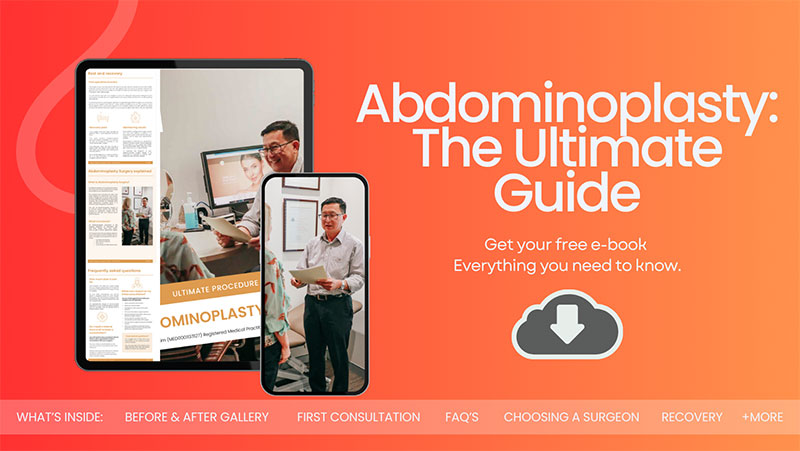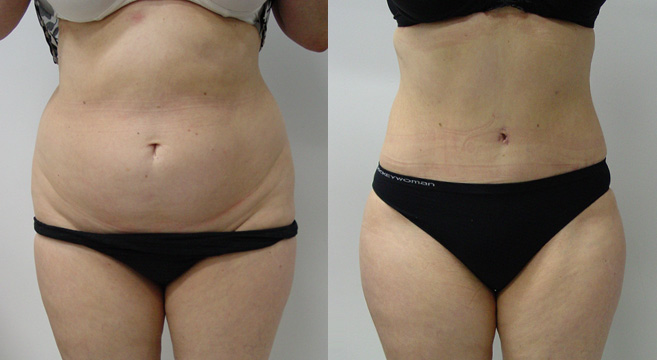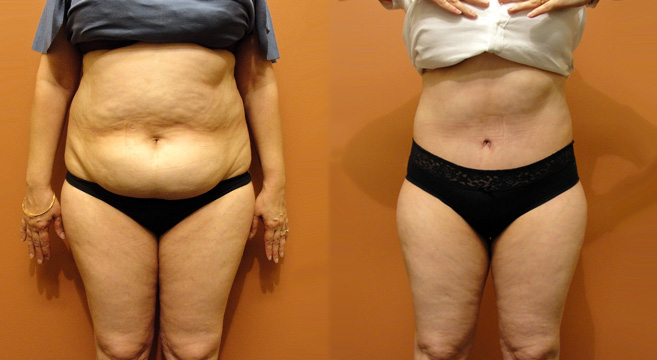Top 25 Most Popular Abdominoplasty FAQs
Abdominoplasty is a complex plastic surgery intervention and, like most cosmetic procedures, it comes with its set of questions and uncertainties. That’s why Sydney Specialist Plastic Surgeon Dr Jake Lim has curated a list of the top 25 most popular FAQs about abdominoplasty. From understanding the basics of the procedure, navigating through the preparation and recovery phases, to managing expectations and outcomes, the goal is to provide you with a thorough insight into what abdominoplasty entails.
Download Dr Lim’s Free 2024 Abdominoplasty Guide

FAQs about Abdominoplasty
1. What is abdominoplasty, and who is an ideal candidate for the procedure?
Abdominoplasty, or a tummy tuck, is a surgical procedure aimed at removing excess skin and fat from the abdomen and tightening the muscles of the abdominal wall. This procedure is recommended for you if you have loose or excess abdominal skin often caused by significant weight loss, pregnancy, ageing, or genetic factors. Good candidates are those at a stable weight, in good physical health, non-smokers, and with realistic expectations about the outcomes of the surgery. It can be considered among women post-pregnancy or individuals who have undergone major weight loss and are left with excess skin.
2. What are the different types of abdominoplasty surgery?
There are primarily two types of abdominoplasty: full abdominoplasty and mini-abdominoplasty. A full abdominoplasty is suitable for individuals who require extensive correction; it involves an incision across the lower abdomen and around the navel. This type allows for the removal of a significant amount of skin and fat, as well as tightening of the abdominal muscles. A mini-abdominoplasty is less invasive, involving a smaller incision and is ideal for those with less excess skin and fat, primarily below the navel. The choice between the two depends on your specific needs and goals.
3. How should I prepare for an abdominoplasty procedure?
Preparation for abdominoplasty involves several steps to ensure optimal outcomes and a smooth recovery. You should stop smoking at least eight weeks before and after surgery to promote better healing. Avoiding aspirin, anti-inflammatory drugs, and herbal supplements that can increase bleeding is also crucial. It’s important to maintain a stable weight and follow a healthy diet to support recovery. Additionally, arranging for someone to drive you home and help you for several days post-surgery is necessary. Finally, discussing all medications and supplements with Dr Lim is essential to avoid any complications.
4. What is the difference between a full abdominoplasty and a mini-abdominoplasty?
The main difference between a full abdominoplasty and a mini-abdominoplasty lies in the extent of correction needed and the invasiveness of the procedure. A full abdominoplasty addresses the entire abdominal area, requiring an incision across the lower abdomen and around the navel to remove excess skin and fat and tighten muscles. It’s suitable for patients needing significant correction. A mini-abdominoplasty targets only the area below the navel with a smaller incision, making it less invasive and ideal for those with minimal excess skin and fat. The muscle is not addressed. The choice between the two depends on your specific condition and desired outcomes.
5. How long does the abdominoplasty surgery take?
The duration of abdominoplasty surgery can vary depending on the extent of the procedure. A full abdominoplasty takes between 2 to 4 hours, while a mini-abdominoplasty may take 1 to 2 hours. The exact time can vary based on individual factors, including the amount of skin and fat to be removed, whether muscle repair is needed, and the specific techniques used by Dr Lim. Dr Lim will provide a more accurate estimate based on your personalised treatment plan during your consultation.
6. What kind of anaesthesia is used during abdominoplasty?
Abdominoplasty is performed under general anaesthesia, ensuring that the patient is asleep and pain-free throughout the procedure. In some cases, particularly for less extensive surgeries like a mini-abdominoplasty, local anaesthesia with sedation may be used, where the patient is awake but relaxed and the abdominal area is numbed. The choice of anaesthesia is determined based on the extent of the procedure, your health and preferences, in consultation with the anaesthesiologist and Dr Jake Lim.
7. What can I expect during the recovery process after an abdominoplasty?
The recovery process after abdominoplasty involves several stages. Initially, you can expect some swelling, bruising, and discomfort, which can be managed with prescribed pain medication. Drains may be placed to remove excess fluid and are usually removed within a week. It’s important to wear a compression garment to support the healing abdomen. You can return to work and light activities within 2-3 weeks, but strenuous activities and heavy lifting should be avoided for 4-6 weeks. Full recovery and final results can take several months as the swelling subsides and the incision lines fade.
8. Are there any risks or complications associated with abdominoplasty?
As with any surgical procedure, abdominoplasty carries certain risks and complications. These may include bleeding, infection, poor wound healing, blood clots, seroma (fluid accumulation), numbness or changes in skin sensation, scarring, and dissatisfaction with the aesthetic results. Risks can be minimised by choosing a qualified and experienced plastic surgeon and by following all pre- and post-operative instructions carefully. It’s important to discuss all potential risks and complications with your surgeon prior to the procedure.
9. How long will it take to see the final results of my abdominoplasty?
While initial improvements may be noticeable shortly after surgery, it can take up to a year for the final results of an abdominoplasty to fully develop. Swelling gradually decreases and incision lines begin to fade over several months. The healing process varies among individuals, and factors such as diet, exercise, and following Dr Lim’s post-operative care instructions can influence the outcome. Patience is important, as the body needs time to adjust and heal for the ultimate contouring effects to emerge.
10. Will there be scarring after abdominoplasty, and if so, how noticeable will it be?
Scarring is an inevitable part of the healing process following abdominoplasty, as incisions are necessary to remove excess skin and fat. The extent and visibility of scars depend on the type of abdominoplasty performed, your healing process and the skill of the surgeon. Typically, Dr Lim places incisions in areas that can be hidden by underwear or a swimsuit. Over time, the scars can fade and become less noticeable, although they never disappear completely.
11. How can I maintain my abdominoplasty results?
Maintaining the results of your abdominoplasty involves adopting a healthy lifestyle. It’s important to engage in regular physical activity and maintain a balanced diet to avoid significant weight fluctuations that can alter the outcome of the surgery. Building a routine that includes strength training can help maintain muscle tone and support the abdominal area. Additionally, staying hydrated and avoiding smoking are important for skin elasticity and overall health. Following Dr Lim’s post-operative care instructions closely will also contribute to lasting results.
12. Is abdominoplasty covered by health insurance?
Abdominoplasty is generally considered a cosmetic procedure and is not typically covered by health insurance. However, if the procedure is deemed medically necessary, such as for the removal of excess skin that causes health issues like rashes or infections, Medicare may offer partial coverage. Medicare also covers the repair of the muscle post pregnancy, especially in those that have experienced back pain and stress incontinence. Make sure to get a GP referral to your consultation with Dr Jake Lim if you are interested in claiming Medicare for your tummy tuck – abdominoplasty procedure.

13. How does pregnancy affect abdominoplasty results?
Pregnancy after abdominoplasty can significantly affect the results of the surgery. The abdominal skin and muscles that were tightened during the procedure may stretch out again due to the pregnancy, potentially reversing the benefits of the tummy tuck – abdominoplasty. For this reason, Dr Jake Lim recommends that women wait until they are done having children before undergoing abdominoplasty. If a pregnancy occurs after the procedure, a revision surgery may be necessary to restore the original results.
14. Can abdominoplasty help with stretch marks?
Abdominoplasty can help reduce the appearance of stretch marks, particularly those located on the skin that is removed during the procedure, which is usually below the belly button. However, it’s important to note that a tummy tuck – abdominoplasty does not specifically target stretch marks and cannot remove them entirely, especially those located outside the area of skin excision. The improvement in the appearance of stretch marks is a secondary benefit to the primary goal of removing excess skin and fat and tightening the abdominal muscles.
15. What is the cost of an abdominoplasty procedure?
The cost of an abdominoplasty procedure can vary widely depending on several factors, including the surgeon’s experience, the geographic location of the practice, the type of abdominoplasty performed (full vs. mini), and any additional procedures that may be done concurrently. It’s important to consider that this price typically includes the surgeon’s fee, anaesthesia, operating room facilities, and any pre- and post-operative care. Always ensure to get a complete breakdown of all costs involved during your consultation.
16. How should I choose a surgeon for my abdominoplasty?
Choosing the right surgeon for your abdominoplasty is essential for achieving the best results and ensuring your safety. Look for a certified plastic surgeon (Fellow of the Royal Australasian College of Surgeons) with extensive experience in body contouring and abdominoplasty procedures. Research their credentials and review before-and-after photos of their previous patients. It’s also important to have a consultation with the surgeon to discuss your goals, ask questions, and ensure you feel comfortable with their approach and communication style. A good surgeon should make you feel informed, confident, and at ease with your decision.
17. What are the limitations of abdominoplasty?
While abdominoplasty can significantly improve the appearance of the abdomen, it’s important to have realistic expectations and understand its limitations. The procedure cannot correct stretch marks outside the excised skin area, nor can it substitute for weight loss or an appropriate exercise program. Additionally, future pregnancies or significant weight fluctuations can affect the results. Abdominoplasty is best suited for individuals close to their ideal body weight who seek to remove excess skin and fat and tighten the abdominal muscles for a smoother, firmer abdominal profile.
18. Can abdominoplasty be combined with other procedures?
Yes, abdominoplasty can be combined with other procedures for more complete body contouring results. Commonly combined procedures include liposuction, to further refine the waistline and remove stubborn fat deposits; breast augmentation, lift (mastopexy), or reduction, for a more balanced body silhouette; and other lifts, such as lower body, thigh or arm lift, to address sagging skin in multiple areas. Combining procedures can offer the advantage of a single recovery period and more visible overall results. However, it’s important to discuss the risks and benefits of combined surgeries with Dr Jake Lim.

19. How does weight gain or loss affect the results of an abdominoplasty?
Significant weight fluctuations after abdominoplasty can negatively impact the results of the surgery. Weight gain can stretch the skin and abdominal muscles that were tightened during the procedure, potentially reversing the aesthetic outcomes. Conversely, significant weight loss after abdominoplasty can lead to additional loose skin. For these reasons, it’s best to undergo abdominoplasty once you’ve achieved and can maintain a stable weight close to your ideal, ensuring the long-lasting effectiveness of the procedure.
20. What is the difference between abdominoplasty and liposuction?
Abdominoplasty and liposuction are both cosmetic procedures aimed at improving the contour of the abdomen, but they address different issues. Abdominoplasty removes excess skin and fat and tightens the abdominal muscles, ideal for individuals with loose or excess skin. Liposuction, on the other hand, is primarily used to remove stubborn fat deposits but does not address excess skin or muscle laxity. In some cases, both procedures may be combined to achieve optimal body contouring results, depending on your needs and goals.
21. How long after giving birth should I wait before undergoing abdominoplasty?
It’s generally recommended to wait at least 6 to 12 months after giving birth before undergoing abdominoplasty. This waiting period allows your body time to recover from pregnancy, for your weight to stabilise, and for any postpartum hormonal changes to normalise. Additionally, if you are breastfeeding, it’s advisable to wait until you have finished to ensure that your breast tissue has returned to its baseline state. This timeline also allows you to reach your post-pregnancy weight goals through diet and exercise, providing a stable foundation for the surgical improvements.
22. What are the signs of a complication after abdominoplasty?
While abdominoplasty is generally safe, it’s important to be aware of potential signs of complications. These may include excessive swelling or bruising, severe or increasing pain not relieved by medication, signs of infection (such as fever, warmth, redness, or discharge at the incision site), unusual bleeding, difficulty breathing, or deep vein thrombosis (characterised by leg pain or swelling). If you experience any of these symptoms, it’s crucial to contact your GP or plastic surgeon immediately for evaluation and potential treatment.
23. How do I manage pain after abdominoplasty surgery?
Pain management after abdominoplasty involves prescribed pain medications from Dr Lim, which should be taken as directed. Additionally, using a compression garment can help reduce discomfort and swelling. It’s important to limit physical activity in the early post-operative period to prevent strain on the surgical site. Techniques such as ice packs (applied according to Dr Lim’s advice) and gentle walks to promote circulation can also aid in pain management.
24. What lifestyle changes should I consider after having an abdominoplasty?
After abdominoplasty, adopting a healthy lifestyle is key to maintaining your results. This includes a balanced diet rich in fruits, vegetables, lean proteins, and whole grains to support healing and maintain weight. Regular exercise, once approved by Dr Jake Lim, is essential for keeping your abdominal muscles strong and your body in shape. Avoiding smoking and limiting alcohol consumption are also important, as these can affect your healing process and overall health. Managing stress and ensuring adequate rest are essential components of a healthy lifestyle post-surgery.
25. Can men undergo abdominoplasty, and if so, how does the procedure differ from that for women?
Yes, men can undergo abdominoplasty, and the number of men seeking this procedure has been increasing. The goals and outcomes are similar to those for women, including removing excess skin and fat and in some cases, tightening the abdominal muscles for a firmer, flatter abdomen. However, the approach may differ slightly due to differences in body composition, fat distribution and goals. Men typically seek a more defined, athletic appearance, which may influence the surgical technique used. The procedure is customised to each individual’s needs and goals, regardless of gender, ensuring that the results are tailored and appropriate.
Further Reading about Abdominoplasty with Sydney Specialist Plastic Surgeon Dr Jake Lim
- Read Dr Jake Lim’s Blog about Recovery after Tummy Tuck – Abdominoplasty
- Read Dr Jake Lim’s Blog about How to Choose the Best Compression Garments after an Abdominoplasty
- Read Dr Jake Lim’s Blog about 5 Methods to Reduce Your Abdominoplasty Scars
- Read Dr Jake Lim’s Blog about What Do the Scars Look Like after Abdominoplasty
- Read Dr Jake Lim’s Blog about Split Muscles after Pregnancy – Diastasis Recti
- Read Dr Jake Lim’s Blog about Mini Tummy Tuck – Abdominoplasty vs. Full Tummy Tuck- Abdominoplasty
- Read Dr Jake Lim’s Blog about Guide to Resuming Exercise after Abdominoplasty
Medical References about Abdominoplasty
- Outcome analysis of combined lipoabdominoplasty versus conventional abdominoplasty
- Extended abdominoplasty: applications and a new classification system for abdominoplasty
- Abdominoplasty: Risk Factors, Complication Rates, and Safety of Combined Procedures
- Revision Abdominoplasty with Truncal Liposculpting: A 10-Year Experience
- Comparison of Aesthetic Quality of the Final Scar in Abdominoplasty with Conventional and Mini Inverted t-Scar




